Abstract
The suburban areas of Galle, just as in many other parts of Sri Lanka, typically have single housing units built on 6 to 20 perch land plots. Most of the plots with single housing units in Galle have been set up with home gardens that can even be used for agricultural purposes. The home gardens serve to provide a relaxing hobby for the home owners while allowing some agricultural produce to be grown for their consumption as well to generate some extra income. Recently, the government has started a campaign to improve the home garden agriculture in each household as a solution to achieving greater self-sufficiency in the people’s food requirements. For this study, 105 households were randomly selected as the sample in the Four Gravets Division in Galle. The dependent variable of the model comprised both Government subsistent families and non-subsistent families. Five independent variables were used with a logistic regression model. The results were incorporated into the GIS model together with their probability values. The results indicated that the higher Wald value and odds ratio for the variable Education are 8.778 and 4.983, followed by Consumption 5.438 and 3.520 and Skilled persons 4.54 and 3.295. Probability values of the Model have been linked with GIS household map to indicate the level of contribution of each household in the home garden agricultural activities. Suggested model can be used to manage the household agricultural system in suburban areas.
Keywords: Householdhome gardenland useurban planningGISGeo statistic
Introduction
In Sri Lanka most of the suburban areas of regional cities have single, detached housing units
scattered about (Silva, 2005). Galle is the third largest city in Sri Lanka and its suburban areas too have a
large number of closely packed single housing units. Galle District essentially has an agriculture based
economy. Therefore, a high proportion of the houses throughout the district are involved in homestead
agriculture (DCSSL, 2012). The Government of Sri Lanka also has a policy of encouraging home garden
agriculture as part of the National Programme. This study examines people’s perception of Home Garden
Agriculture in the suburban areas of Galle by conducting a survey of households engaged in this activity.
This approach it is expected will be useful for understanding the issues relating to this subject and pave the
way for its further development. Especially, individual household agricultural production will contribute
towards food security, promote nutrition and health, and prove to be of economic advantage to those
involved.
Household , Home Garden and Suburban
According to the definition of Soemarwoto and Conway (1992) a home garden is the result of a
unique combination of high levels of productivity, stability, sustainability, and equitability of a household
in a particular area. The condition and quality of a home garden will depend upon the dispersion pattern of
the household (Amerasinghe & d'Auria, 2007).A suburb can also mean one of the residential areas
surrounding a big city and a group of these can collectively be regarded as the suburbs. They can actually
form part of a really big city, or they can be aggregates of several distant residential areas. Quite often, it is
seen that the suburbs have a lower population density than the main urban territory (Irwin & Bockstael,
2004).
Study Area
In the Galle District there are 19 Divisional Secretariat Divisions. Based on data analysis done in
Galle, the Gravets Division had the highest number of suburban home agriculture gardens. The Galle Four
Gravets Division consists of 50 Grama Niladari Divisions (GNDs) as shown in Figure
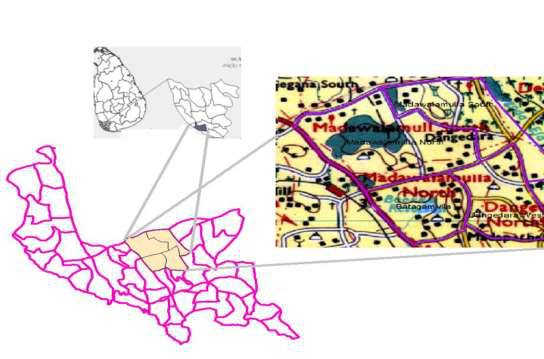
Problem Statement
Home gardening has gradually entrenched itself as an essential economic activity among the low
income and middle income households in the suburban areas of Sri Lanka (Deadman, 2005). Although low
income households are involved in home gardening primarily for economic gains, the middle income
households use it to partly meet their food requirements and also as a relaxing and fulfilling pastime.
Recognizing this, the study will examine the current practices and issues relating to home gardening in the
suburban areas. A limited number of typical suburban areas in the City of Galle, Sri Lanka have been
selected for the study. The logistic statistical model in conjunction with the Geographic Information System
was applied in the analysis (Hills & Trucano, 1999).
Research Questions
What is the current context of home garden householders in Suburban areas
How to assess the benefits of home gardening in suburban areas
Purpose of the Study
(a)To examine the profiles of current home garden householders in suburban areas
(b)To assess the benefits of home gardening to householders in suburban areas
(c)To identify strategies to promote home garden agriculture
(d)To build a geo-statistical model for improving home gardening practices in Sri Lanka
Research Methods
Selection of Core Study Area:
Out of the 50 GN Divisions, 4 GN Divisions were identified as the most important, based on
population (Figure
analysis of secondary data in combination with the multi-layers of the Geographical Information System
(Bernhardsen, 2002), the GN Divisions of Madawalamulla North, Madawalamulla South, Dangedara West
and Bataganwila were identified as the most suitable core areas to conduct the survey.
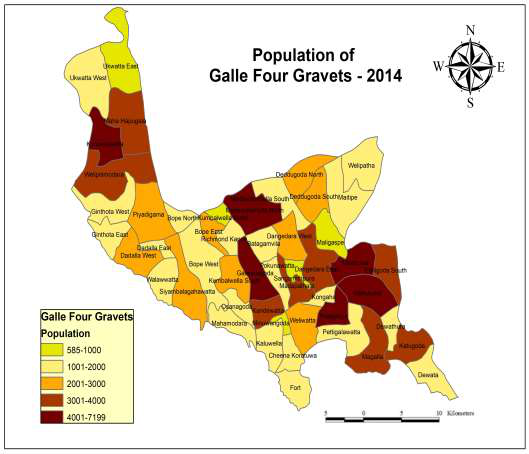
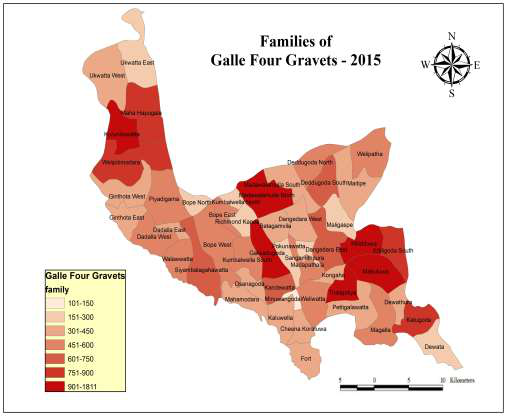
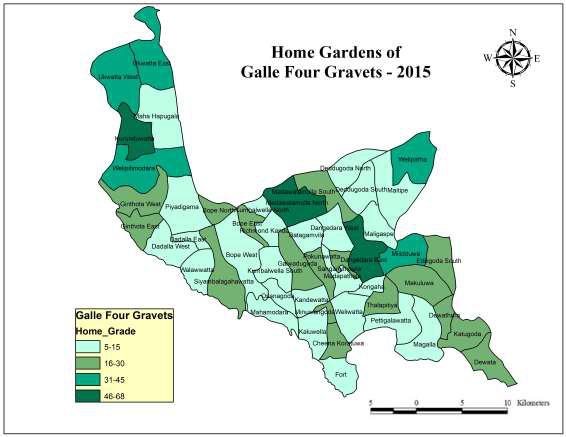
Sample
In the core study area, 105 households have been plotted using GPS (Ayalew & Yamagishi, 2005)
in a field survey and classified into two categories as low income and middle income. The plotted
households in the field with their real locations (denoted by GPS coordinate values) are illustrated in Figure
5. Samples have been selected using a reasonable distribution method in the spatial areas (Abeykoon, 2004).
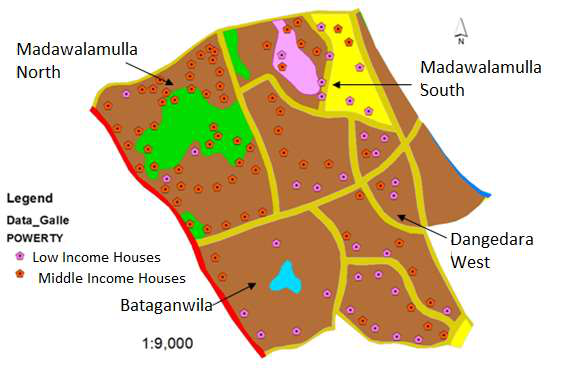
Methods
This study employs two research methods/ techniques. One is the Logistic Regression model (Hosmer & Lemeshow, 2004) to assess the benefits of home garden agriculture. The following Applied Multivariate Logistic Model formula is used for the study: Y = B0 + B1 X1 + B2 X2 + B3 X3 + B4 X4+ B5 X5............................. (1)
Where,
Y = Low Income/ Samurdhi = 0 & Middle Income/ Non-Samurdhi = 1
X1 = Consumption
X2 = Occupation
X3 = Family Income
X4 = Income from Home Gardening
X5 = Level of Education
Secondly, the predicted value derived from this formula has to be incorporated with the housing locations to find the best performing houses in respect of home garden agriculture in the study area (Bewick, Cheek, & Ball, 2005).
Findings
Accuracy of Model: Table 1 indicates that the entire data model is reliable and consistent showing a 77.1% correct percentage for data model. The model correctly classified 77.3 percent of cases overall at step one of the step-wise model run, indicating the high accuracy achieved.
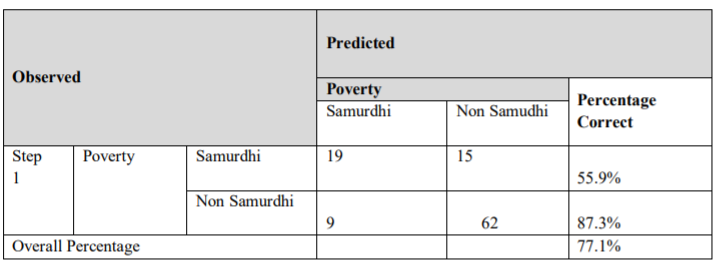
Model Running and Results
Table 2 illustrates the values of the independent variables obtained for all 105 families. After assessing the low income families and the middle income families, it was apparent that the overall education level of suburban residents has a lot of potential to allow them to engage in home gardening agriculture. The educational level of the area has an odds ratio of 4.983, Wald value of 8.778 and significance of 0.003. This is followed by consumption, which has an odds ratio of 3.520 and Wald value of 5.423; occupation has an odds ratio of 3.295 and Wald value of 4.540. In addition, family income variable shows no change either in the low income or middle income category even if it has some significance in the database. However, agricultural output and production value are not significant.

Probability value classification
Probability value chart shown in Figure
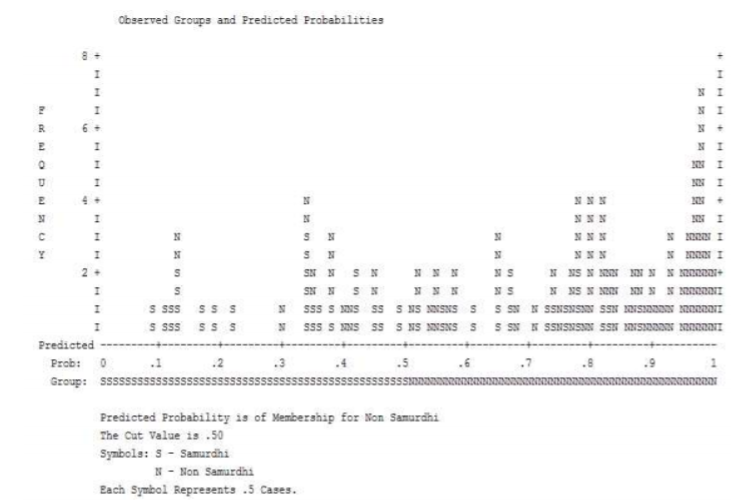
GIS Model and Household Spatial Distribution
Figure
agriculture. Households depicted in green colour have high probability values while those in red colour
have low probability values. The spatial distribution map is very important for making policy decisions,
assessing environmental impacts and as a guide to future studies.
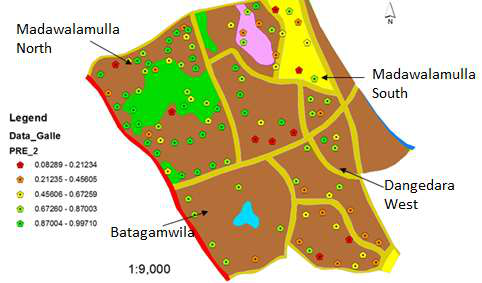
Conclusion
This pilot survey was conducted to assess the status of household based agriculture in suburban
areas. Results indicate that presently middle and high income families have a strong interest in taking up
home garden based agriculture as they know that it can provide them with fresh food, a healthy hobby and
some extra income. Even the Government of Sri Lanka has a policy to improve the economy of low income
families through Home Garden Agriculture. This study has proved that the level of education of middle
income groups involved in home garden agriculture was higher by 4.938 comparing with low income
groups. The value of 4.938 (odds ratio) results have been compatibly support with the value of significance
0.003 and Wald value of 8.778 for middle income households than low income households. Secondly, home
garden agriculture has been used for consumption by the middle income group 3.52 times more compared
to the low income families. Further, a majority of skilful persons from middle income households appreciate
the importance of home based agriculture 3.295 times more than the less skilful persons from low income
households.
On the other hand, both groups think alike that home gardening could generate some extra income
but are not too confident about it because it has an odds ratio of 1.00. Both low income groups as well as
middle income groups have indicated that their home gardening agricultural production is still not at a
satisfactory level and needs to improve. In any case, policies intended to promote home garden based
agriculture must take into consideration the fact that family income also plays a crucial role in achieving a
successful outcome.
Acknowledgments
Authors acknowledge School of Humanities, Universiti Sains Malaysia regard waived of
registration fees for INCoH 2017
References
- Amerasinghe, A.Auria, V. D. (2007). Matara: Project [re] formulation.. Colombo, European Union
- Abeykoon, A. T. P. L. (2004). Research, Data and Policy Issues on Ageing in Sri Lanka. Ageing population in Sri Lanka: Issues and Future prospects.. United Nations Population Fund, Colombo, 256-276
- Ayalew, L.Yamagishi, H. (2005). The application of GIS-based logistic regression for landslide susceptibility mapping in the Kakuda-Yahiko Mountains, Central Japan.. Geomorphology, 65(1), 15-31
- Bernhardsen, T. (2002). Geographic information systems: an introduction
- Bewick, V.Cheek, L.Ball, J. (2005). Statistics Review 14: Logistic regression.. Crit Care, 9(1), 112-118
- DCSSL [Department of Census and Statistics], (2012). Department of Census and Statistics. 2012 Census of population and housing.. Sri Lanka, DCSL
- Deadman, P. (2005). Household Decision Making and Patterns of Land Use Change in LUCITA: An Agent Based Simulation of the Altamira Region, Brazil
- Hills, R. G.Trucano, T. G. (1999). Statistical validation of engineering and scientific models: Background.. Sandia National Laboratories, SAND99-, 1256, 36-
- Hosmer, D. W.Lemeshow, S. (2004). Applied Logistic Regression
- Irwin, E. G.Bockstael, N. E. (2004). Land use externalities, open space preservation, and urban sprawl.. Regional science and urban economics, 34(6), 705-725
- Silva, W. I. D. (2005). Family transition in South Asia: provision of social services and social protection.. Asia Pacific Population Journal, 20(2), 13-
- Soemarwoto, O.Conway, G. R. (1992). The javanese homegarden.. Journal for Farming Systems Research-Extension, 2(3), 95-118
Copyright information

This work is licensed under a Creative Commons Attribution-NonCommercial-NoDerivatives 4.0 International License.
About this article
Publication Date
23 September 2019
Article Doi
eBook ISBN
978-1-80296-067-9
Publisher
Future Academy
Volume
68
Print ISBN (optional)
-
Edition Number
1st Edition
Pages
1-806
Subjects
Sociolinguistics, linguistics, literary theory, political science, political theory
Cite this article as:
Hemakumara*, G., Senarath, G., Prabhashini, S., & Samat, N. (2019). Assessing The Home Garden Agriculture In The Suburban Areas In Galle-Sri Lanka. In N. S. Mat Akhir, J. Sulong, M. A. Wan Harun, S. Muhammad, A. L. Wei Lin, N. F. Low Abdullah, & M. Pourya Asl (Eds.), Role(s) and Relevance of Humanities for Sustainable Development, vol 68. European Proceedings of Social and Behavioural Sciences (pp. 669-677). Future Academy. https://doi.org/10.15405/epsbs.2019.09.73
